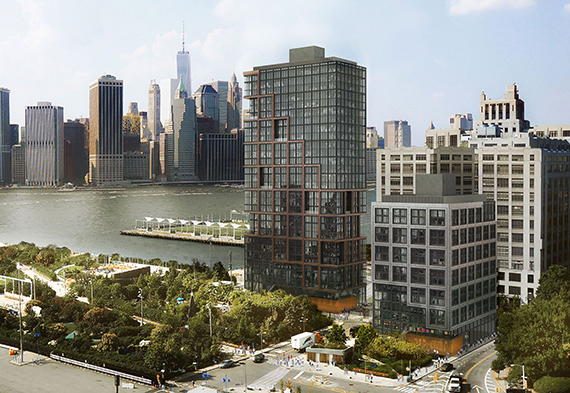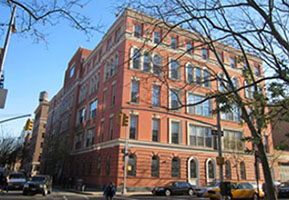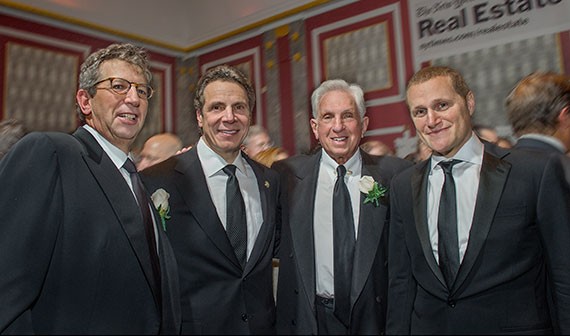Trending
Real estate industry takes serious collateral damage in Cuomo-de Blasio war
Industry players grow frustrated over “childish” feud between governor and mayor

A little over a year ago, Mayor Bill de Blasio unleashed a rant about a revenge-hungry presence in Albany: Gov. Andrew Cuomo.
“What I found was, he engaged in his own sense of strategies, his own political machinations, and what we’ve often seen is, if someone disagrees with him openly, some kind of revenge or vendetta follows,” de Blasio told NY1.
It was a rare moment of bluntness in what was previously a behind-closed-doors feud, one that industry insiders say is terrible for business and the cause of major headaches such as the death of the 421a tax abatement program and delays in the issuance of state-backed housing bonds.
“The thing about the conflict between the mayor and the governor is it’s like water polo,” said a representative for a major Manhattan-based developer. “You see them thrashing around at each other on the surface, but below the surface is where the real kicks are happening.”
Perks of the office
Cuomo and de Blasio go back at least two decades. The governor was de Blasio’s boss in the late 1990s when Cuomo served as secretary of the Department of Housing and Urban Development in the Clinton administration. The two were close, with de Blasio referring to Cuomo as his mentor. When de Blasio scored an improbable victory in the 2013 mayoral race, Cuomo canceled his annual New Year’s open house at the governor’s mansion so he could be there for the inauguration ceremony.
But their relationship quickly soured over issues such as universal pre-K, a pet de Blasio proposal that Cuomo managed to steal the limelight on. And it’s hit a new low over the battle on 421a, with Cuomo taking a pro-union stance and de Blasio arguing that the need for housing trumped the issue of a prevailing wage for workers.
It’s almost a New York tradition for the governor and mayor to be rivals. George Pataki and Rudy Giuliani sparred frequently, and Gov. Nelson Rockefeller and Mayor John Lindsay were thought to have a particularly acidic relationship.
“The relationship between mayors and governors has always been a flash point,” said one broker. “They still found ways to work together because it’s in everyone’s interest.” This time, however, things are different.
Some say the clashes stem from the two men’s very different personalities: the governor is vindictive, they say, while the mayor is naive. “It doesn’t seem that the mayor was aware what he was biting on to chew by taking on the governor,” said a developer’s representative. “It’s like a kindergartener going toe-to-toe with a high schooler.” The two men avoid being in the same room, the representative said, but get angry if one is invited to a meeting and not the other. Both men were present at the Real Estate Board of New York’s annual gala in January, but did not interact.
Another theory is that Cuomo is paranoid about not being the “liberal lion” that his father, Gov. Mario Cuomo, was. He feels that the mayor, unlike his centrist predecessor Michael Bloomberg, has stepped in and taken over some of that progressive turf.
”The problem between them has little to do with policy and everything to do with personality and ego,” a person familiar with the situation said. “When it comes to the governor, there are basically two ways of playing ball. You either do what he tells you to do, or you get out of the way.”
421 things I hate about you
Developers blame the feud for the lapse of the tax abatement program in January, which has hamstrung new projects and put a damper on the city’s investment sales market. Some said the governor intentionally shifted responsibility for the program’s future to REBNY and Building and Construction Trades Council of Great New York in order to deprive the mayor of a victory on his affordable housing agenda. Evan Thies, founder of public relations firm Brooklyn Strategies, said the governor simultaneously gained points with labor groups and jeopardized the mayor’s signature campaign pledge.
“It just slowed down what everyone thought was going to be a pretty perfunctory process,” said Thies, who formerly worked on Cuomo’s campaign for New York Attorney General. “The 421a issue was really about the fact that this was potentially going to create a big win for [de Blasio’s] affordable housing agenda.”
When asked how the mayor’s relationship with the governor has impacted key real estate policies, a spokesperson for de Blasio didn’t address the question directly.
“While we’ve certainly battled some headwinds, our affordable housing plan is ahead of schedule and on budget,” the spokesperson, Austin Finan, said in an e-mail. “We hope Albany will be an active partner in this effort.”
From the beginning, the mayor and governor clashed over the abatement. In May 2015, the mayor put forward a plan that would require developers receiving the abatement to include a certain percentage of affordable housing in their projects. Cuomo publicly denounced the mayor’s suggestion, saying it favored developers and only certain labor groups and wouldn’t fly. (A spokesperson for the governor’s office reiterated on Friday that the mayor’s proposal was unworkable, since it didn’t offer prevailing wages to all construction workers). The next month, Cuomo, Assembly Speaker Carl Heastie and Sen. Majority Leader John Flanagan presented a new deal that closely mirrored the mayor’s plan, with a catch: Union representatives and developers needed to reach an accord over the prevailing wage.
At the CIO-AFL’s 33rd Constitutional Convention on Aug. 22, the governor again took a swing at the city’s 421a proposal.
“The second issue is the way the city proposed the law, which came to Albany,” Cuomo said . “The program does not pay union wages. Why? Because the developers don’t want to be forced to use union labor, because if they are left on their own they want to use nonunion labor.”
Richard Anderson, president of the New York Building Congress, acknowledged Cuomo and de Blasio’s mutual animosity possibly contributed to the delay in working out 421a, but believes Cuomo wouldn’t have stepped forward with his own proposal if messing with the mayor was his only goal. He added, however, that shifting the tax break’s fate to the private sector was unreasonable.
“It put them in an untenable position,” he said. “They should not be asked to do the legislature’s job. They kicked the can down the road.”
Two weeks ago, Cuomo proposed a solution to the 421a impasse. It is strikingly similar to de Blasio’s proposal, with one exception: instead of mandating prevailing wages at 421a developments, the new program would include a required an average minimum wage for construction workers. For Brooklyn and Queens projects, a portion of those wages will be paid through state subsidies.
Some developers expressed scepticism about the plan, which is yet to get REBNY’s blessing.
“What Cuomo is proposing seems very odd to me, to have wage subsidies” said one. “I think that that was purely this feud. I see no reason for what de Blasio proposed (in 2015) not to be done.”
Another squarely blamed Cuomo for the trouble the impasse caused his firm by forcing it to start construction on several rental projects before the abatement expired.
“The incompetence in Albany required us to jump through so many hoops to put a pile in the ground,” he said.
Brooklyn Bridge over troubled water

Rendering of the Pier 6 development at Brooklyn Bridge Park (credit: ODA)
De Blasio and Cuomo also clashed over a residential development planned at Brooklyn Bridge Park’s Pier 6. In May, the Empire State Development Corporation pulled its support for the project, citing concerns that its developer, RAL Development Services, donated $10,000 to the mayor’s Campaign for One New York in May 2015, a few months before the developer was selected to develop the site. At an ESD meeting the next day, a representative for the city fired back. Peter Wertheim, board member and advisor to deputy Mayor Alicia Glen, voted against awarding two contracts to Tishman Construction for work on the Jacob K. Javits Center, noting that Daniel Tishman — chair of the construction company, which he sold to AECOM in 2010 — is one of Cuomo’s top political contributors.
“To me, it feels interesting to sit here and be asked to vote on an $8 million contract for one of the governor’s largest donors,” Wertheim said at the time.
A month later, the state changed its mind and backed the Pier 6 project.
“This is just the state fucking with the city,” said one residential developer who is not involved in the project, arguing that the state withholding support for the project made it easier for local NIMBYs to challenge it.
Fraying bonds
In November 2015, the governor’s office and City Hall began a public spat over federal housing bonds, which are allocated by the state. The de Blasio administration claimed it received a far smaller share of the bonds than it was promised, and later said it was forced to delay plans to develop 1,200 affordable housing units. “At the time of the de Blasio administration’s request, all of the [bonds] had been allocated,” a Cuomo spokesperson later told Crain’s.
When news broke in February that Albany hadn’t, in fact, come close to its cap on bond issuance in 2015, some housing advocates immediately suspected the Cuomo-de Blasio feud played a role. Last year, the city received a reported $595 million in bonds, the lowest level in five years and a far cry from the $785 million the state had initially indicated it would send.
By June, the two sides appeared to have resolved the dispute. At the time, the de Blasio administration said it had received $426 million in bonds year-to-date, including $140 million in bonds exceeding its fixed allocation (a flashpoint in the 2015 dispute). A well-connected housing advocate told TRD that no major projects went unfunded as a result. Still, the advocate acknowledged that there was a delay.

Rivington House at 45 Rivington Street
Speak no evil
Arguably the biggest headache for the de Blasio administration in recent months has been the Rivington House scandal. Earlier this year, news broke that the de Blasio administration had lifted a deed restriction on a Lower East Side nursing home owned by a major campaign donor, who promptly sold it for a massive profit to a development group that plans to convert it into condos.
The governor has been uncharacteristically quiet about the incident, and there are good possible reasons for that. For one, Cuomo reportedly had a (minor) role in the drama. Long before the sale, the operator VillageCare noticed that the nursing home was facing falling demand. So it asked to turn the property into a geriatric facility. According to a 2014 article on NYPress.com, Cuomo, who at the time planned to eliminate 5,000 nursing home beds across the state, rejected the request.
There is also the possibility that U.S. Attorney Preet Bharara’s current investigation into Bill de Blasio’s fundraising, which reportedly includes the Rivington House case, could be a mere warmup for an investigation into the governor. A May profile of Bharara in the New Yorker noted that he sees his anti-corruption activity in Albany as “unfinished.”
Two years ago, the mayor actually came to the governor’s defense amid allegations that Cuomo disbanded his anticorruption panel — the Moreland Commission — because it came too close to his allies. At the time, Cuomo was running for re-election.
“I can tell you something about Andrew Cuomo. I’ve known him for almost 20 years,” de Blasio told reporters. “I think he is a person of high integrity.”
Picking sides

Bill Rudin, Gov. Andrew Cuomo, Stephen Green and Rob Speyer at the 2014 REBNY gala (Credit: Steve Friedman)
During an interview with TRD in March, REBNY president John Banks said he didn’t see the issue over 421a as permanently scarring the industry’s relationship with the governor.
“A relationship as deep and as long as the real estate industry’s relationship with the governor is not impacted by one issue, per se,” Banks said. “I don’t see that as a fatal problem in the relationship.”
Others are less optimistic. Several developers TRD spoke to said the feud made them question Cuomo’s ability to govern.
“Most people in the industry hate the governor at this point,” one said. “The kindergarten nature of Cuomo’s needing to be the biggest baddest guy and being determined to shove the mayor’s face in the mud at every turn – it’s so transparently vindictive.” The increasing frustration with Cuomo, who used to have a reputation of being close to the real estate industry and was widely considered to be more likely to side with business interests than de Blasio, is striking.
Still, few are willing to criticize the governor openly for fear of retaliation. And picking sides in the dispute is a bad idea, said one broker, because many developments depend on both state and city approval.
“Your best bet is to be Switzerland,” he said.
Though the governor and mayor ostensibly share similar interests — like encouraging a vibrant tech sector in New York to rival Silicon Valley, curb homelessness and increase the minimum wage — they haven’t joined forces. One real estate executive said that it’s impossible to measure how many opportunities — in terms of state and city collaborations — have been missed due to their feud. For instance, he doesn’t expect the state’s Empire State Development Corporation to collaborate with its city counterpart, the Economic Development Corporation, on large-scale infrastructure projects.
“There’s no conversation. I don’t think they’ve even met with one another. I think there’s missed opportunity,” he said.
He thinks too many of the governor’s decisions have been shaped by his dislike for the mayor. Cuomo is picking on the mayor because he can, the executive said, while the mayor also hasn’t “done himself any favors.”
“They’ve been able to get away thus far without having to do much work together, but God forbid in an instance where a hurricane or something worse, they are really going to need to come together, and those relationships are not there,” he said. “So far, that hasn’t cost anyone that dearly, but it may.”




